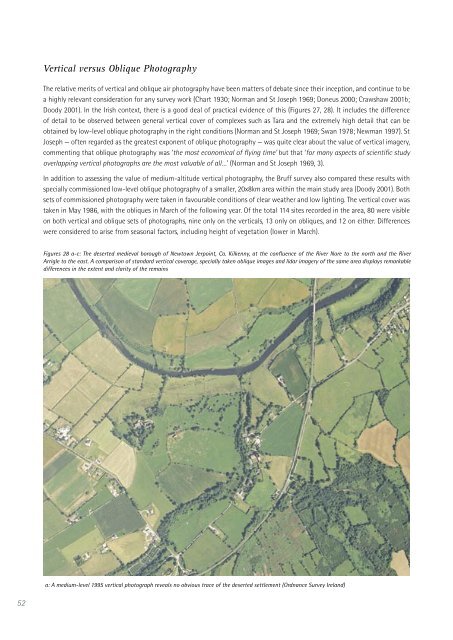Aerial Archaeology in Ireland - The Heritage Council
Aerial Archaeology in Ireland - The Heritage Council
Aerial Archaeology in Ireland - The Heritage Council
Create successful ePaper yourself
Turn your PDF publications into a flip-book with our unique Google optimized e-Paper software.
52<br />
Vertical versus Oblique Photography<br />
<strong>The</strong> relative merits of vertical and oblique air photography have been matters of debate s<strong>in</strong>ce their <strong>in</strong>ception, and cont<strong>in</strong>ue to be<br />
a highly relevant consideration for any survey work (Chart 1930; Norman and St Joseph 1969; Doneus 2000; Crawshaw 2001b;<br />
Doody 2001). In the Irish context, there is a good deal of practical evidence of this (Figures 27, 28). It <strong>in</strong>cludes the difference<br />
of detail to be observed between general vertical cover of complexes such as Tara and the extremely high detail that can be<br />
obta<strong>in</strong>ed by low-level oblique photography <strong>in</strong> the right conditions (Norman and St Joseph 1969; Swan 1978; Newman 1997). St<br />
Joseph — often regarded as the greatest exponent of oblique photography — was quite clear about the value of vertical imagery,<br />
comment<strong>in</strong>g that oblique photography was ‘the most economical of fly<strong>in</strong>g time’ but that ‘for many aspects of scientific study<br />
overlapp<strong>in</strong>g vertical photographs are the most valuable of all…’ (Norman and St Joseph 1969, 3).<br />
In addition to assess<strong>in</strong>g the value of medium-altitude vertical photography, the Bruff survey also compared these results with<br />
specially commissioned low-level oblique photography of a smaller, 20x8km area with<strong>in</strong> the ma<strong>in</strong> study area (Doody 2001). Both<br />
sets of commissioned photography were taken <strong>in</strong> favourable conditions of clear weather and low light<strong>in</strong>g. <strong>The</strong> vertical cover was<br />
taken <strong>in</strong> May 1986, with the obliques <strong>in</strong> March of the follow<strong>in</strong>g year. Of the total 114 sites recorded <strong>in</strong> the area, 80 were visible<br />
on both vertical and oblique sets of photographs, n<strong>in</strong>e only on the verticals, 13 only on obliques, and 12 on either. Differences<br />
were considered to arise from seasonal factors, <strong>in</strong>clud<strong>in</strong>g height of vegetation (lower <strong>in</strong> March).<br />
Figures 28 a-c: <strong>The</strong> deserted medieval borough of Newtown Jerpo<strong>in</strong>t, Co. Kilkenny, at the confluence of the River Nore to the north and the River<br />
Arrigle to the east. A comparison of standard vertical coverage, specially taken oblique images and lidar imagery of the same area displays remarkable<br />
differences <strong>in</strong> the extent and clarity of the rema<strong>in</strong>s<br />
a: A medium-level 1995 vertical photograph reveals no obvious trace of the deserted settlement (Ordnance Survey <strong>Ireland</strong>)

















